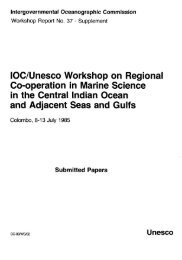Manual on sea level measurement and ... - unesdoc - Unesco
Manual on sea level measurement and ... - unesdoc - Unesco
Manual on sea level measurement and ... - unesdoc - Unesco
- No tags were found...
You also want an ePaper? Increase the reach of your titles
YUMPU automatically turns print PDFs into web optimized ePapers that Google loves.
Sea Level Measurement <strong>and</strong> Interpretati<strong>on</strong><strong>sea</strong> <strong>level</strong>s. It begins with the classical method of AnnualExtremes, which first appeared in the early 1960s <strong>and</strong>c<strong>on</strong>tinued to be developed for some time thereafter.Following this, the Joint Probability Method, which wasdeveloped in the late 1970s, is c<strong>on</strong>sidered. This makesmore efficient use of data by incorporating our extensiveknowledge of the tides <strong>and</strong> storm surges, whichare the two main comp<strong>on</strong>ents of <strong>sea</strong> <strong>level</strong>, as a part ofthe estimati<strong>on</strong> procedure.More recent work <strong>on</strong> the Annual Exceedance Method isdiscussed, followed by a revisi<strong>on</strong> of the Joint ProbabilityMethod to correct its deficiencies in areas where the <strong>sea</strong><strong>level</strong> is dominated by the meteorological surge comp<strong>on</strong>ent.Finally, very recent work <strong>on</strong> the spatial estimati<strong>on</strong>of extremes is menti<strong>on</strong>ed. References are given at eachstage so that the reader can examine any of the methodsin greater depth. Although extreme high <strong>sea</strong> <strong>level</strong>sare c<strong>on</strong>sidered, results for extreme low <strong>sea</strong> <strong>level</strong>s can beobtained in an analogous way.2.8.2 The Annual Maximum Method (AMM)This is the classical general method of analysis ofextremes having been applied to <strong>sea</strong> <strong>level</strong> estimati<strong>on</strong>since 1963 (Lenn<strong>on</strong>, 1963; Suth<strong>on</strong>s, 1963). It is based<strong>on</strong> a result from probabilistic extreme value theorywhich states: if X 1 ,... X n is a sequence of independent<strong>and</strong> identically distributed r<strong>and</strong>om variables, thenmax(X 1 ,... X n ), suitably linearly normalized, c<strong>on</strong>vergesas n ∞ , to a r<strong>and</strong>om variable with a distributi<strong>on</strong>functi<strong>on</strong> which is <strong>on</strong>e of the so called extremevaluedistributi<strong>on</strong>s. The general case is known as theGeneralized Extreme Value (GEV) distributi<strong>on</strong>. Animportant special case is the Gumbel distributi<strong>on</strong>.The Annual Maximum Method takes the GEV to bethe distributi<strong>on</strong> functi<strong>on</strong> of the maximum <strong>sea</strong> <strong>level</strong> ina year. Therefore, for a place of interest, the annualmaximum for each year is extracted from hourly observati<strong>on</strong>s<strong>and</strong> is used as data to estimate the parametersof the distributi<strong>on</strong> that they follow. From the estimateddistributi<strong>on</strong> <strong>on</strong>e can obtain the <strong>sea</strong> <strong>level</strong> corresp<strong>on</strong>dingto a chosen ‘Return Period’. In practice, return periodsof 50, 100 <strong>and</strong> 1,000 years are comm<strong>on</strong>. The basicmethod assumes that there is no trend in the data, butit can be extended to deal with those cases where atrend is present.A recent extensi<strong>on</strong> of the annual maximum methodinvolves using probabilistic extreme value theory toobtain the asymptotic joint distributi<strong>on</strong> of a fixed number(r) of the largest independent extreme values, forexample the five largest in each year. Essentially theapproach is the same as above except that more relevantdata are included in the analysis thereby improvingthe estimati<strong>on</strong>. Care must be taken to ensure that thenumber of annual maxima ‘r’ is not excessive, such thatthe lower extremes fall outside the tail of the extremevalue distributi<strong>on</strong>.This method of estimating <strong>sea</strong> <strong>level</strong> extremes is highlyinefficient in its use of data, since it extracts very fewvalues from each yearly record. This is particularly importantwhen the <strong>sea</strong> <strong>level</strong> record is short, since it yieldsreturn <strong>level</strong> estimates with unacceptably large st<strong>and</strong>arderrors. In additi<strong>on</strong>, it makes no use of our knowledge ofthe <strong>sea</strong> <strong>level</strong> <strong>and</strong> storm surge processes. However, theadvantage of annual maxima methods is that they d<strong>on</strong>ot require knowledge of tide–surge interacti<strong>on</strong> whichcan sometimes be a significant feature of the data.C<strong>on</strong>sequently the methods are relatively straightforwardto apply.2.8.3 The Joint Probabilities Method (JPM)This method of analysis was introduced to exploit ourknowledge of the tide in short data sets to which theannual maxima method could not be applied (Pugh<strong>and</strong> Vassie, 1979). At any time, the observed <strong>sea</strong> <strong>level</strong>,after averaging out surface waves, has three comp<strong>on</strong>ents:mean <strong>sea</strong> <strong>level</strong>, tidal <strong>level</strong> <strong>and</strong> meteorologicallyinduced <strong>sea</strong> <strong>level</strong>. The latter is usually referred to as astorm surge. Using st<strong>and</strong>ard methods, the first two ofthese comp<strong>on</strong>ents can be removed from the <strong>sea</strong> <strong>level</strong>sequence leaving the surge sequence, which is just thetime-series of n<strong>on</strong>-tidal residuals. For simplicity these areassumed to be stati<strong>on</strong>ary. Because the tidal sequenceis deterministic, the probability distributi<strong>on</strong> for all tidal<strong>level</strong>s can be generated from tidal predicti<strong>on</strong>s. Thisdistributi<strong>on</strong> can be accurately approximated using 18.6years of predicti<strong>on</strong>s.The probability distributi<strong>on</strong> of hourly <strong>sea</strong> <strong>level</strong>s can beobtained either directly using an empirical estimate orby combining the tidal <strong>and</strong> surge probability densityfuncti<strong>on</strong>s (pdf). The latter is preferable, as it smoothes<strong>and</strong> extrapolates the former. However the nature ofthe combinati<strong>on</strong> of the pdf’s depends <strong>on</strong> whetherthere is dependence between the tide <strong>and</strong> surgesequences. Initially, c<strong>on</strong>sider the case in which theyare independent.By combining the pdf’s of tide <strong>and</strong> surge, the distributi<strong>on</strong>functi<strong>on</strong> of hourly (instantaneous) <strong>sea</strong> <strong>level</strong>s is obtained.From this, the distributi<strong>on</strong> functi<strong>on</strong> of the annual maximais required. If hourly values were independent, whichis approximately the case where the tide dominates theregime, then this is straightforward.The method has been widely applied. It makes betteruse of the data <strong>and</strong> of our extensive knowledge of thetides, <strong>and</strong> accounts for surges that could have occurred<strong>on</strong> high tide but by chance did not. Most successfulapplicati<strong>on</strong>s have been to sites which have several yearsof hourly records (>10 years) <strong>and</strong> where the site is tidallydominant, i.e. where the tidal range is large in comparis<strong>on</strong>to the surge amplitude. Least successful applicati<strong>on</strong>shave been to sites with both short lengths of data <strong>and</strong>where the site is surge dominant.8IOC <str<strong>on</strong>g>Manual</str<strong>on</strong>g>s <strong>and</strong> Guides No 14 vol IV
















